 Rembrandt Harmenszoon van Rijn (1606 – 1669) was a Dutch painter and etcher. He is generally considered one of the greatest painters and printmakers in European art history and the most important in Dutch history, says Wikipedia.[1] His contributions to art came in a period that historians call the Dutch Golden Age.
Rembrandt Harmenszoon van Rijn (1606 – 1669) was a Dutch painter and etcher. He is generally considered one of the greatest painters and printmakers in European art history and the most important in Dutch history, says Wikipedia.[1] His contributions to art came in a period that historians call the Dutch Golden Age.
Having achieved youthful success as a portrait painter, his later years were marked by personal tragedy and financial hardship. Yet his etchings and paintings were popular throughout his lifetime, his reputation as an artist remained high,[2] and for twenty years he taught nearly every important Dutch painter.[3]
Rembrandt's greatest creative triumphs are exemplified especially in his portraits of his contemporaries, self-portraits and illustrations of scenes from the Bible. His self-portraits form a unique and intimate biography, in which the artist surveyed himself without vanity and with the utmost sincerity.[1]
Rembrandt[6] Harmenszoon van Rijn was born on July 15, 1606 in Leiden, the Netherlands. He was the ninth child.[7] His family was quite well-to-do; his father was a miller and his mother was a baker's daughter. As a boy he attended Latin school and was enrolled at the University of Leiden, although according to a contemporary he had a greater inclination towards painting; he was soon apprenticed to a Leiden history painter, Jacob van Swanenburgh, with whom he spent three years.
After a brief but important apprenticeship of six months with the famous painter Pieter Lastman in Amsterdam, Rembrandt opened a studio in Leiden in 1624 or 1625, which he shared with friend and colleague Jan Lievens. In 1627, Rembrandt began to accept students, among them Gerrit Dou.[8]
In 1629 Rembrandt was discovered by the statesman Constantijn Huygens, the father of Christiaan Huygens (a famous Dutch mathematician and physicist), who procured for Rembrandt important commissions from the court of The Hague. As a result of this connection, Prince Frederik Hendrik continued to purchase paintings from Rembrandt until 1646.[9]
At the end of 1631, Rembrandt moved to Amsterdam, then rapidly expanding as the new business capital of the Netherlands, and began to practice as a professional portraitist for the first time, with great success. He initially stayed with an art dealer, Hendrick van Uylenburg, and in 1634, married Hendrick's cousin, Saskia van Uylenburg.[10] Saskia came from a good family: her father had been lawyer and burgemeester (mayor) of Leeuwarden.
In 1635 Rembrandt and Saskia moved into their own house, renting in fashionable Nieuwe Doelenstraat. In 1639, they moved to a prominent house (now the Rembrandt House Museum) in the Jodenbreestraat in what was becoming the Jewish quarter; the mortgage to finance the 13,000 guilder purchase would be a primary cause for later financial difficulties.[12]
He should easily have been able to pay it off with his large income, but it appears his spending always kept pace with his income, and he may have made some unsuccessful investments.[13] It was there that Rembrandt frequently sought his Jewish neighbors to model for his Old Testament scenes.
During Saskia's illness, Geertje Dircx was hired as Titus' caretaker and nurse and probably also became Rembrandt's lover.
In the late 1640s Rembrandt began a relationship with the much younger Hendrickje Stoffels, who had initially been his maid. In 1654 they had a daughter, Cornelia, bringing Hendrickje a summons from the Reformed Church to answer the charge "that she had committed the acts of a whore with Rembrandt the painter".
Among the more prominent characteristics of his work are his use of chiaroscuro, the theatrical employment of light and shadow derived from Caravaggio, or, more likely, from the Dutch Caravaggisti, but adapted for very personal means.[33] Also notable are his dramatic and lively presentation of subjects, devoid of the rigid formality that his contemporaries often displayed, and a deeply felt compassion for mankind, irrespective of wealth and age.
His immediate family—his wife Saskia, his son Titus and his common-law wife Hendrickje—often figured prominently in his paintings, many of which had mythical, biblical or historical themes.
A parallel development may be seen in his skill as a printmaker. In the etchings of his maturity, particularly from the late 1640s onward, the freedom and breadth of his drawings and paintings found expression in the print medium as well. The works encompass a wide range of subject matter and technique, sometimes leaving large areas of white paper to suggest space, at other times employing complex webs of line to produce rich dark tones.[37]
Rembrandt painted The Militia Company of Captain Frans Banning Cocq between 1640 and 1642. This picture was called the Nachtwacht by the Dutch and the Night Watch by Sir Joshua Reynolds because, upon its discovery, the picture was so dimmed and defaced by time that it was almost indistinguishable and it looked quite like a night scene. After it was cleaned, it was discovered to represent broad day—a party of musketeers stepping from a gloomy courtyard into the blinding sunlight.
 - 1606 - 1669
- 1606 - 1669
- dramatic lighting: chiaroscuro (Italian, "Light-dark")
- portraits
- realism
- etching / prints
- teacher of best Dutch artists
- late 1600's a Golden Age for Holland in trade and empire-building
- Amsterdam
- Nord Zee (North Sea)
- Netherlands (low lands)
* ship design
* trading, banking
* empire: Indonesia, South Africa, Caribbean islands (Curacao), New Amserdam.
* Holland's neighbors: Germany, France, Belgium, England.
* Royal Dutch petroleum
* Phillips Electronics (cassette)
* Heineken, Grolsch, Amstel beers
* Gouda cheese
* Dutch utopian spirit
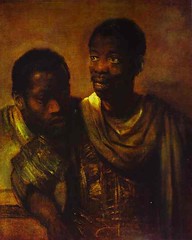 Chiaroscuro (Italian for light-dark) in art is contrast between light and dark, usually bold contrasts affecting a whole composition, says Wikipedia.
Chiaroscuro (Italian for light-dark) in art is contrast between light and dark, usually bold contrasts affecting a whole composition, says Wikipedia.
It is also more technically used by artists and art historians for the use of effects representing contrasts of light, not necessarily strong, to achieve a sense of volume in modeling three-dimensional objects such as the human body.
 1. The pigments of the Paleolithic paintings of Lascaux are derived from: a) vegetation b) minerals c) incisions in the stone d) fire.
1. The pigments of the Paleolithic paintings of Lascaux are derived from: a) vegetation b) minerals c) incisions in the stone d) fire.
2. In the Nave of Lascaux is a figure whose limbs show an unusually early grasp of a) length b) equines c) aurochs d) perspective.
3. Bos primigenius was not an a) auroch b) urus c) bovine d) hematite.
4. Finds of Paleolithic cave art range from Russia to Portugal. T / F
5. The face of the Venus of Willendorf resembles that of a fertility ritual or of a doll.
T / F
6. Sister Wendy is a particularly appropriate "contemplative hermit." T / F
7. The eye of Horus might also be termed the eye of Ra. T / F
8. The Book of Kells is a masterwork of what is termed Insular illumination. That term means a) vivid illustrations b) golden decorations c) island art d) swirling motifs.
9. The Book of Kells represents the early Northern European culture called the
a) Irish b) Christian c) Celts d) Latins.
10. In the illuminated book Les Tres Riches Heures du Duc de Berry the "hours" refers to a) prayer b) his royal life c) seasons of the year d) honesty.
11. Holden Caulfield: a) Dickens b) Shakespeare c) Proust d) Salinger.
12. Chiaroscuro: a) shadow and light b) impasto c) faux marbre d) trompe l'oeil.
13. What ethnic enclave is implied by Rembrandt's address on Jodenbreestraat?
a) merchants b) Dutch Protestants c) Jews d) nouveau riche.
14. The Dutch empire included Caribbean islands. T / F
15. The Rhine flows from Switzerland to a) Amsterdam b) Koln c) Nord Zee
d) English Channel.
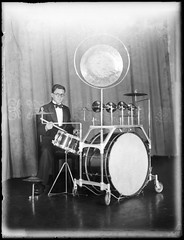 All students should have an opportunity to sit behind a drum kit, a trap set, to feel the physical reality of the snare, tom, kick pedal and high hat. Happily, we have prof Joe LeBlanc, musician and and teacher, to show us how they work.
All students should have an opportunity to sit behind a drum kit, a trap set, to feel the physical reality of the snare, tom, kick pedal and high hat. Happily, we have prof Joe LeBlanc, musician and and teacher, to show us how they work.
I've also asked him to show us the guts of a piano. We'll take a look at the felt-covered hammers that are part of the character of a pianoforte.
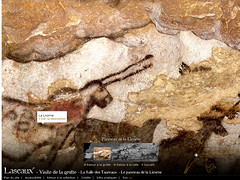 The cave at Lascaux, France, contains nearly 2,000 figures, which can be grouped into three main categories — animals, human figures and abstract signs. Notably, says Wikipedia, the paintings contain no images of the surrounding landscape or the vegetation of the time[6]. Most of the major images have been painted onto the walls using mineral pigments( red and yellow ochre, hematite, manganese oxide and charcoal), although some designs have also been incised into the stone.
The cave at Lascaux, France, contains nearly 2,000 figures, which can be grouped into three main categories — animals, human figures and abstract signs. Notably, says Wikipedia, the paintings contain no images of the surrounding landscape or the vegetation of the time[6]. Most of the major images have been painted onto the walls using mineral pigments( red and yellow ochre, hematite, manganese oxide and charcoal), although some designs have also been incised into the stone.
The most famous section of the cave is The Great Hall of the Bulls where bulls, equines and stags are depicted. But it is the four black bulls that are the dominant figures among the 36 animals represented here. One of the bulls is 17 feet (5.2 m) long — the largest animal discovered so far in cave art. Additionally, the bulls appear to be in motion.
A painting referred to as "The Crossed Bison" and found in the chamber called the Nave is often held as an example of the skill of the Paleolithic cave painters. The crossed hind legs show the ability to use perspective in a manner that wasn't seen again until the 15th century.
Many of the bovine figures are aurochs.
The aurochs or urus (Bos primigenius), the ancestor of domestic cattle, was a type of huge wild cattle which inhabited Europe, Asia and North Africa, but is now extinct; it survived in Europe until 1627.
 Paleolithic cave art developed across Europe, from the Urals to the Iberian Peninusula, from 35,000 to 11,000 BC. The Paleolithic Age is the Old Stone Age.
Paleolithic cave art developed across Europe, from the Urals to the Iberian Peninusula, from 35,000 to 11,000 BC. The Paleolithic Age is the Old Stone Age.
Because of their deep galleries, isolated from external climatic influences, these caves are particularly well preserved. The caves are inscribed as masterpieces of creative genius and as the humanity’s earliest accomplished art.
Altamira (Spanish for 'high view') is a cave in Spain famous for its Upper Paleolithic cave paintings featuring drawings and polychrome rock paintings of wild mammals and human hands.
 This stone-carving, dated between 24,000 and 22,000 BCE, has been dubbed Venus of Willendorf because she was found in Willendorf, Austria. Today she's housed in a museum in nearby Vienna.
This stone-carving, dated between 24,000 and 22,000 BCE, has been dubbed Venus of Willendorf because she was found in Willendorf, Austria. Today she's housed in a museum in nearby Vienna.
It is carved from an oolitic limestone that is not local to the area, and tinted with red ochre.
Is she a primal mother goddess, representation of women or a particular woman, an image used in fertility rituals, or a doll?
The Venus is not a realistic portrayal, notes Wikipedia, but rather an idealization of the female figure. The figure has no visible face, her head being covered with circular horizontal bands of what might be rows of plaited hair, or a type of headdress.[2]
 The tomb paintings associated with the Pharaonic era are the basis of Beckett's second stop in her History of Painting.
The tomb paintings associated with the Pharaonic era are the basis of Beckett's second stop in her History of Painting.
The time is 3000 BC.
Recent scholarship, btw, links the construction of the Sphinx to the builder of the second great pyramid, Pharaoh Kahfre.
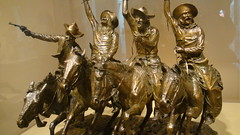 Frederic Sackrider Remington (October 4, 1861 - December 26, 1909) was an American painter, illustrator, sculptor, and writer who specialized in depictions of the Old American West, specifically concentrating on the last quarter of the 18th century American West and images of cowboys, American Indians, and the U.S. Cavalry.
Frederic Sackrider Remington (October 4, 1861 - December 26, 1909) was an American painter, illustrator, sculptor, and writer who specialized in depictions of the Old American West, specifically concentrating on the last quarter of the 18th century American West and images of cowboys, American Indians, and the U.S. Cavalry.
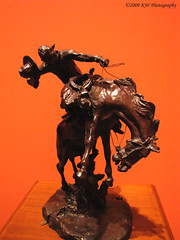 Charles Marion Russell (March 19, 1864, St. Louis, Missouri—October 24, 1926, Great Falls, Montana)[1], also known as C. M. Russell, was an artist of the American West, says Wikipedia . Russell created more than 2,000 paintings of cowboys, Indians, and landscapes set in the Western United States, in addition to bronze sculptures. Known as 'the cowboy artist'[2], Russell was also a storyteller and author. The C. M. Russell Museum Complex is located in his hometown of Great Falls, Montana houses more than 2,000 Russell artworks, personal objects, and artifacts.
Charles Marion Russell (March 19, 1864, St. Louis, Missouri—October 24, 1926, Great Falls, Montana)[1], also known as C. M. Russell, was an artist of the American West, says Wikipedia . Russell created more than 2,000 paintings of cowboys, Indians, and landscapes set in the Western United States, in addition to bronze sculptures. Known as 'the cowboy artist'[2], Russell was also a storyteller and author. The C. M. Russell Museum Complex is located in his hometown of Great Falls, Montana houses more than 2,000 Russell artworks, personal objects, and artifacts.
Russell's mural entitled Lewis and Clark Meeting the Flathead Indians hangs in the state capitol building in Helena, Montana. Russell's 1918 painting Piegans sold for $5.6 million dollars at a 2005 auction [3].
Please read more on Wikipedia and About.com and peruse a photo search on Flickr.com and other sites.
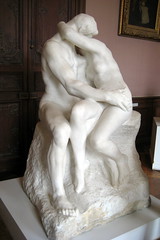 Auguste Rodin[p] (born François-Auguste-René Rodin; 12 November 1840 – 17 November 1917) was a French sculptor, notes Wikipedia.
Auguste Rodin[p] (born François-Auguste-René Rodin; 12 November 1840 – 17 November 1917) was a French sculptor, notes Wikipedia.
Although Rodin is generally considered the progenitor of modern sculpture,[1] he did not set out to rebel against the past. He was schooled traditionally, took a craftsman-like approach to his work, and desired academic recognition,[2] although he was never accepted into Paris's foremost school of art.
Sculpturally, he possessed a unique ability to model a complex, turbulent, deeply pocketed surface in clay. Many of Rodin's most notable sculptures were roundly criticized during his lifetime. They clashed with the predominant figure sculpture tradition, in which works were decorative, formulaic, or highly thematic.
Rodin's most original work departed from traditional themes of mythology and allegory, modeled the human body with realism, and celebrated individual character and physicality. Rodin was sensitive of the controversy surrounding his work, but refused to change his style. Successive works brought increasing favor from the government and the artistic community.
From the unexpected realism of his first major figure—inspired by his 1875 trip to Italy—to the unconventional memorials whose commissions he later sought, Rodin's reputation grew, such that he became the preeminent French sculptor of his time. By 1900, he was a world-renowned artist. Wealthy private clients sought Rodin's work after his World's Fair exhibit, and he kept company with a variety of high-profile intellectuals and artists.
He married his life-long companion, Rose Beuret, in the last year of both their lives. His sculpture suffered a decline in popularity after his death in 1917, but within a few decades his legacy solidified. Rodin remains one of the few sculptors widely known outside the visual arts community.
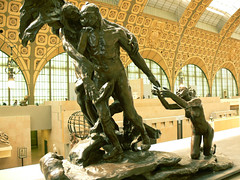 A tragic destiny, writes the capable person who posted this photo from the famous Musee D'Oursay, Paris.
A tragic destiny, writes the capable person who posted this photo from the famous Musee D'Oursay, Paris.
Camille was the sister of the catholic writer Paul Claudel. An exceptionally gifted sculptor, she got to work for Rodin, and became his lover. He often used her works as his own, and treated her rather shabbily.
Camille sank progressively into psychosis, and her brother took this as a pretext to lock her up in an asylum, never to let her out again for decades. Only recently she has become recognized for the genius she was.
See The Women in Rodin's Life.
And I recommend the movie Camille Claudel.
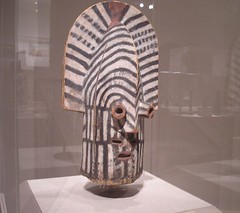 The masks, fabrics, sculptures, dance and music of African art are appreciated globally. Art from the continent of Africa (continent of Africa) does not simply exist in its own realm. It has had a profound impact on many areas of the art world.
The masks, fabrics, sculptures, dance and music of African art are appreciated globally. Art from the continent of Africa (continent of Africa) does not simply exist in its own realm. It has had a profound impact on many areas of the art world.
Picasso, Braque and Modigliani are among the famous 20th century artists who have used African work as a source. Musician Paul Simon (the Graceland album, 1986, sold 14 million copies) is another artist who has borrowed from African rhythms and melodies and synthesized an artful body of work.
In Fine Arts Survey our mission will be to identify and describe that which is most celebrated about African art.
* masks (Tyler, Alex J, Andrew)
* fabrics (Gentry)
* music (Lindsay, Jackie, Ali, Davis)
* dance
* costume / dress
* jewelry (Lauren, Emily, Lesa)
* drums and other instruments (Jesse, Cavett, Michael, Thomas, Jon)
* cave art
* body art (Kelly, Lindsey, Alexis, Hannah)
* architecture (Alex B, Andy, Kyle)
Then we will identify the ways in which its influence has changed Western art.
Finally, we will see a local exhibit of African art in the gallery at Southern Museum of Art Shreveport (SUMAS).
How many of you have an African mask or Yoruba fertility figure or African-inspired jewelry?
African art presentation (25 pts)
- 10 images - with brief commentary and source - which colorfully explain the art area you've chosen (see above).
- 2 images - w commentary - of African influence on western art.
- Titling.
- Bibliography image.
- Five review questions (mult-choice) for the class as the final image.
Deadline Wed, Sept 16. To be presented in class via GoogleDocs.
Fri, Sept 18: 10 pts - full-size bar of soap for a lesson in relief sculpture. The subject matter: African masks.
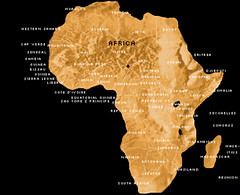 West Africa:
West Africa:
a) the source of European trade and slaves, thus the region with the greatest connection to the US and Caribbean.
b) the gold mines of West Africa enabled the rise of powerful cultures during the Middle Ages. Notable groups: the Yoruba, Ghana, Songhai Empire.
c) Slavery has been practiced in Africa, as well as other places, throughout recorded history, says Wikipedia.[35][36] Between the seventh and twentieth centuries, Arab slave trade (also known as slavery in the East) took 18 million slaves from Africa via trans-Saharan and Indian Ocean routes. Between the fifteenth and the nineteenth centuries, the Atlantic slave trade took 7–12 million slaves to the New World.[37][38][39]
Africa north of the Sahara, or Mediterranean Africa:
a) colonized by the Persians, Greeks and Romans, the life in Northern Africa is considerably different from Sub-Sharan Africa.
Egypt produced one of the first high cultures of history.
At about 3300 BC, the historical record opens in Northern Africa with the rise of literacy in the Pharaonic civilisation of Ancient Egypt.[21] One of the world's earliest and longest-lasting civilizations, the Egyptian state continued, with varying levels of influence over other areas, until 343 BC.
East Africa is the home of Swahili culture. Swahili mixes the Arabic traders' influence with those from the later colonizers, the Germans and other Europeans. Swahili is both a language and a culture.
Southern Africa is the wealthiest part of the continent. Deposits of gold and diamonds, rich farmland and additional minerals have made South Africa rich.
East Africa's central nations are considered the most physically beautiful. Nations such as Kenya and Tanzania are the site of the big-game safaris and other tourism.
The Rift Valley of East Africa is considered the home of human kind.
Africa is considered by most paleoanthropologists to be the oldest inhabited territory on Earth, with the human species originating from the continent.[11][12] During the middle of the twentieth century, anthropologists discovered many fossils and evidence of human occupation perhaps as early as 7 million years ago. Fossil remains of several species of early apelike humans thought to have evolved into modern man, such as Australopithecus afarensis (radiometrically dated to approximately 3.9–3.0 million years BC)
 A relief is a sculptured artwork where a modelled form is raised, or in sunken-relief lowered, from a plane from which the main elements of the composition project (or sink), says Wikipedia.
A relief is a sculptured artwork where a modelled form is raised, or in sunken-relief lowered, from a plane from which the main elements of the composition project (or sink), says Wikipedia.
Reliefs are common throughout the world, for example on the walls of monumental buildings. The frieze in the classical Corinthian order is often enriched with bas-relief (low relief). Alto-relievo (high-relief) may be seen in the pediments of classical temples, e.g., the Parthenon.
A bas-relief ("low relief", French pronunciation: [baʁəljɛf], from the Italian basso rilievo) or low relief is the quality of an projecting image where the overall depth is shallow. The background is very compressed or completely flat, as on most coins, on which all images are in low-relief.
Lorenzo Ghiberti's gilded bronze "Doors of Paradise", Baptistery, Florence combine high relief main figures with backgrounds mostly in low relief.
Bas-relief is very suitable for scenes with many figures and other elements such as a landscape or architectural background. A bas-relief may use any medium or technique of sculpture, but stone carving and metal casting are the traditional ones. If more than 50% of most rounded or cylindrical elements such as heads and legs project from the background, a sculpture is usually considered to be "alto rilievo" or "high relief", although the degree of relief within both types may vary across a composition, with prominent features such as faces in higher relief.
Illustration above from Darius the Great's audience hall in Persia, today's Iran. Darius I was both builder of the vast Persian Empire and an enlightened ruler.
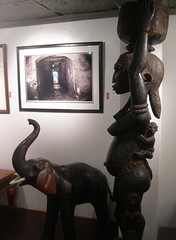 The mission of the Southern University Museum of Art at Shreveport (SUMAS) is to assure that the art, artifacts, and other treasured works of Africans, African-Americans and their descendants are accessible to the community in an organized and cherished collection, in a place of historic significance on the campus of Southern University at Shreveport.
The mission of the Southern University Museum of Art at Shreveport (SUMAS) is to assure that the art, artifacts, and other treasured works of Africans, African-Americans and their descendants are accessible to the community in an organized and cherished collection, in a place of historic significance on the campus of Southern University at Shreveport.
African Art: SUMAS features African art from the major art-producing regions of Africa including: Mali, Nigeria, the Ivory Coast of West Africa, Cameroon, and the Congo.
The African art exhibit is comprised of two major collections: The Southern University System President Dr. Leon R. Tarver, II Collection and the Dr. William Bertrand Collection.
The two include over 300 artifacts and represent the foundation of the museum's permanent collection of African art.
The African art collections include: ceremonial masks, statues, fabric, utensils, and a variety of other functional artifacts. The current exhibit features a "Gbekre Monkey Figure" from the Baoule people of the Ivory Coast, an Ekoi Head Crest with two braided horns, a clay Boli (four-legged buffalo) from the Bamana people of Mali, and jewelry from the Bertrand Collection of artifacts from the Congo. Each artifact is unique and has a functional use in the culture of the country of its origin.
African-American Art: The Museum features African-American art from the permanent collection of the Southern University Museum of Art in Baton Rouge.
Hours
* SUMAS is located at 610 Texas Street on the first floor of the SUSLA Metro Center in downtown Shreveport.
* Hours are Tuesday through Friday, 10 a.m until 5 p.m. and Saturday 10 a.m until 4 p.m.
* Admission is free.
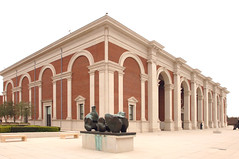 The Meadows Museum, a division of SMU's Meadows School of the Arts, houses one of the largest and most comprehensive collections of Spanish art outside of Spain, with works dating from the tenth to the twentieth century.
The Meadows Museum, a division of SMU's Meadows School of the Arts, houses one of the largest and most comprehensive collections of Spanish art outside of Spain, with works dating from the tenth to the twentieth century.
It includes masterpieces by some of the world's greatest painters: El Greco, Velázquez, Ribera, Murillo, Goya, Miró, and Picasso.
Highlights of the collection include Renaissance altarpieces, monumental Baroque canvases, exquisite rococo oil sketches, polychrome wood sculptures, Impressionist landscapes, modernist abstractions, a comprehensive collection of the graphic works of Goya, and a select group of sculptures by major twentieth-century masters - Rodin, Maillol, Giacometti, Moore, Smith, and Oldenburg - as well as works by leading artists of the region - Frank Reaugh, Jerry Bywaters, Otis Dozier, Alexandre Hogue, and William Lester.
Algur H. Meadows developed an interest in art during frequent visits to Spain during the 1950s, when he spent long afternoons at the great Museo Nacional del Prado in Madrid. Mr. Meadows began to collect Spanish art, and his collection has grown to be one of the finest outside of Spain.
Algur Meadows is also the founder of Meadows Museum of Art Shreveport.
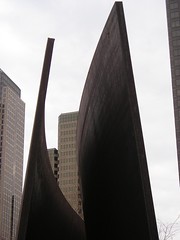 The Nasher Sculpture Center is a museum in Dallas, Texas specializing in modern and contemporary sculpture. It is located on a 2.4-acre (9,700 m2) site adjacent to the Dallas Museum of Art in the heart of the Dallas Arts District.
The Nasher Sculpture Center is a museum in Dallas, Texas specializing in modern and contemporary sculpture. It is located on a 2.4-acre (9,700 m2) site adjacent to the Dallas Museum of Art in the heart of the Dallas Arts District.
The museum was a longtimedream of the late Raymond and Patsy Nasher (Ray was the original owner of NorthPark Center), who together formed a comprehensive collection of masterpieces by Harry Bertoia, Constantin Brâncuşi, Alexander Calder, Raymond Duchamp-Villon, Paul Gauguin, Willem de Kooning, Mark di Suvero, Alberto Giacometti, Barbara Hepworth, Ellsworth Kelly, Henri Matisse, Joan Miró, Henry Moore, Claes Oldenburg, Pablo Picasso, Auguste Rodin, Richard Serra, and David Smith, among others, which continues to grow and evolve.
Renzo Piano, winner of the Pritzker Prize in 1998, is the architect of the Center’s 55,000-square-foot (5,100 m2) building. Piano worked in collaboration with landscape architect Peter Walker on the design of the 2-acre (8,100 m2) Garden.
On display in the Galleries and Garden are rotating exhibitions of works from the Nasher Collection as well as special exhibitions drawn from other museums and private collections. In addition to indoor and outdoor gallery spaces, the Center contains an auditorium, education and research facilities, a cafe, and a store.
 Much of the work of Africa is in wood. Sculpture, drums, jewelry, etc.
Much of the work of Africa is in wood. Sculpture, drums, jewelry, etc.
Among the most notable woods associated with Africa:
Ebony is a general name for very dense black wood. In the strict sense it is yielded by several species in the genus Diospyros, but other heavy, black (or dark colored) woods (from completely unrelated trees) are sometimes also called ebony.
Ebony is one of the most intensely black woods known, which, combined with its very high density (it is one of the woods that sink in water), fine texture, and ability to polish very smoothly, has made it very valuable as an ornamental wood.
Ebony has a long history of use, with carved pieces having been found in Ancient Egyptian tombs. The word "ebony" derives from the Ancient Egyptian hbny, via the Ancient Greek ἔβενος (ébenos), by way of Latin and Middle English.
By the end of the 16th century, fine cabinets for the luxury trade were made of ebony in Antwerp. The dense hardness lent itself to refined moldings framing finely detailed pictorial panels with carving in very low relief (bas-relief), usually of allegorical subjects, or scenes taken from classical or Christian history. Within a short time, such cabinets were also being made in Paris, where their makers became known as ébénistes, which remains the French term for a cabinetmaker.
Modern uses are largely restricted to small sizes, particularly in musical instrument making, including piano and harpsichord keys, violin, viola, guitar, and cello fingerboards, endpieces, pegs and chinrests. Traditionally, black piano and harpsichord keys were ebony, and the black pieces in chess sets were made from ebony, with rare boxwood or ivory being used for the white pieces.
Teak (Tectona), is a genus of tropical hardwood trees in the mint family, Lamiaceae[1][2][3], native to the south and southeast of Asia, and is commonly found as a component of monsoon forest vegetation. They are large trees, growing to 30-40 m tall, deciduous in the dry season.
The name teak comes from the Malayalam[4] word Thekku.
The yellowish brown timber with good grains and texture from teak trunk is used in the manufacture of outdoor furniture, boat decks, and other articles where weather resistance is desired. It is also used for indoor flooring and as a veneer for indoor furnishings.
Teak is easily worked and has natural oils that make it suitable for use in exposed locations and termite and pest proof, where it is durable even when not treated with oil or varnish. Timber cut from old Teak trees grown slowly in natural forests is more durable and harder; teak from young trees grown in plantations is more prone to splitting and water damage, however kiln drying allows for sustainable, plantation-grown teak to perform nearly on par with old-growth teak.
The name mahogany is used when referring to numerous varieties of dark-coloured hardwood, it is an American Indian word originally used for the wood of the species Swietenia mahagoni, known as West Indian or Cuban mahogany.
Mahogany has a generally straight grain and is usually free of voids and pockets. It has a reddish-brown color, which darkens over time, and displays a beautiful reddish sheen when polished. It has excellent workability, and is very durable. The size of the trees meant that wide boards were once available (and still are of the non-endangered varieties). These properties make it a favourable wood for crafting furniture.
Much of the first-quality furniture made in the American colonies from the mid 1700s, when the wood first became available to American furniture makers, was made of mahogany. Mahogany resists wood rot, which makes it suitable for boat construction. It is also often used for musical instruments, particularly the backs of guitars.
Mahogany is used for drum making, because of its integrity and capability to produce a very dark, warm tone (as compared to other more common wood types like maple or birch).
A wide variety of electric guitars are also made with mahogany, like Gibson's Les Paul.
Mahogany is also commonly used in acoustic guitars. The wood is most often used to make the back, sides, or neck of a guitar, but it is sometimes used to make the top (soundboard) as well. Guitars with mahogany soundboards tend to have a softer, darker tone than those made from spruce.
Bubinga: The best-known Guibourtia timber is bubinga (Guibourtia demeusei, aka kevazingo). Another is ovangkol. Species of Guibourtia also produce Congo copal.
The wood is often used by luthiers for harps and other instruments, such as bass guitars, because of its mellow and well-rounded sound. It has been used in drum shells as well. Drum companies such as Tama offer various high-end drum kits with plies of Bubinga in the shells[4].
Bubinga is sometimes used in the production of archery bows, in particular as the main wood of the handle in some flat bows.
Bubinga is also used in furniture making, usually for tables, as large slabs of the dense wood can be cut, and with very little manipulation, be used for a table top.
Bubinga often has an appearance similar to the mineral tiger eye. Light brown through dark brown and red, some samples show as almost purple.
Luxury car maker Lexus also makes use of the wood in their luxury vehicles.
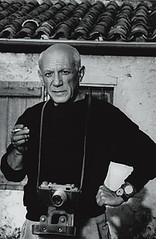 Pablo Diego José Francisco de Paula Juan Nepomuceno María de los Remedios Cipriano de la Santísima Trinidad Ruiz y Picasso (25 October 1881 – 8 April 1973) was a Spanish painter, draughtsman, and sculptor, says Wikipedia.
Pablo Diego José Francisco de Paula Juan Nepomuceno María de los Remedios Cipriano de la Santísima Trinidad Ruiz y Picasso (25 October 1881 – 8 April 1973) was a Spanish painter, draughtsman, and sculptor, says Wikipedia.
Commonly known simply as Picasso, he is one of the most recognized figures in 20th-century art. He is best known for co-founding the Cubist movement and for the wide variety of styles embodied in his work. Among his most famous works are the proto-Cubist Les Demoiselles d'Avignon (1907) and Guernica (1937), his portrayal of the German bombing of Guernica during the Spanish Civil War.
Picasso demonstrated uncanny artistic talent in his early years, painting in a realistic manner through his childhood and adolescence; during the first decade of the twentieth century his style changed as he experimented with different theories, techniques, and ideas.
Picasso’s creative genius manifested itself in numerous mediums, including painting, sculpture, drawing, and architecture. His revolutionary artistic accomplishments brought him universal renown and immense fortunes throughout his life, making him the best-known figure in twentieth century art. His fame has continued after his death, firmly establishing his status as one of the greatest artists in Western history.
 Movement. Drama. Dynamism. These three words describe the essence of the work of sculpture known as the Nike of Samothrace, says Art History at Loggia.com.
Movement. Drama. Dynamism. These three words describe the essence of the work of sculpture known as the Nike of Samothrace, says Art History at Loggia.com.
This image of the Greek goddess Nike demonstrates, in a powerful and impressive manner, the level of technical skill achieved by Hellenistic sculptors. The Nike of Samothrace is quite literally a tour de force of intricate carving and dynamic movement, an image of Victory captured for eternity.
For the ancient Greeks, the goddess Nike represented the personification of victory.
While she now commands attention in the Louvre as a free-standing statue, originally the Nike was part of scene that included a ship's prow. The beautiful goddess must have been an awe-inspiring sight, appearing to drift from the sky and land gracefully, wings still hovering in the air, draperies moving in the wind and revealing the elegant body underneath.
Today, in many ways the Nike celebrates the victory of beauty, as she symbolizes the ideals of perfection to which the ancient Hellenistic artists aspired. And the statue of the goddess still stands as a monument to a time of artistic splendor.
 Lysippos was a Greek sculptor of the 4th century BC, says Wikipedia. Together with Scopas and Praxiteles, he is considered one of the three great sculptors of the Classical Greek era, bringing transition into the Hellenistic period.
Lysippos was a Greek sculptor of the 4th century BC, says Wikipedia. Together with Scopas and Praxiteles, he is considered one of the three great sculptors of the Classical Greek era, bringing transition into the Hellenistic period.
Notable: his large workshop, the demand for replicas of his work in his lifetime[1] and later among Hellenistic and Roman connoisseurs, the number of disciples directly in his circle,[2] and the survival of his works only in copies.
Among the works attributed to him are the so-called Horses of Saint Mark, Eros Stringing the Bow (of which various copies exist, the best in the British Museum), Agias (known for a marble copy found and preserved in Delphi), the similar Oil Pourer (Dresden and Munich), the Farnese Hercules (which was originally placed in the Baths of Caracalla, although the surviving marble copy lies in the Naples National Archaeological Museum) and Apoxyomenos (or The Scraper, known from a Roman marble copy in the Vatican Museums).
Herma bust of Alexander, Roman marble reflecting an original by Lysippos (Louvre)
Born at Sicyon around 390 BC Lysippos was a worker in bronze in his youth. He taught himself the art of sculpture, later becoming head of the school of Argos and Sikyon. According to Pliny, he produced more than 1,500 works, all of them in bronze. Commentators noted his grace and elegance, and the symmetria or coherent balance of his figures, which were leaner than the ideal represented by Polykleitos and with proportionately smaller heads, giving them the impression of greater height. He was famous for his attention to the details of eyelids and toenails.
His pupil, Chares of Lindos, constructed the Colossus of Rhodes, one of the Seven Wonders of the Ancient World. As this statue does not exist today, debate continues as to whether it was cast bronze or hammered of sheet bronze.
 The Parthenon Marbles are a collection of classical Greek marble sculptures, inscriptions and architectural members that originally were part of the Parthenon and other buildings on the Acropolis of Athens, says Wikipedia.[1][2]
The Parthenon Marbles are a collection of classical Greek marble sculptures, inscriptions and architectural members that originally were part of the Parthenon and other buildings on the Acropolis of Athens, says Wikipedia.[1][2]
Thomas Bruce, 7th Earl of Elgin, the British ambassador to the Ottoman Empire from 1799–1803, had obtained a controversial permission from the Ottoman authorities to remove pieces from the Acropolis. From 1801 to 1812 Elgin's agents removed about half of the surviving sculptures of the Parthenon, as well as architectural members and sculpture from the Propylaea and Erechtheum.[3] The Marbles were transported by sea to Britain.
In Britain, the acquisition of the collection was supported by artists and others,[4] while some critics compared Elgin's actions to vandalism[5] or looting.[6][7][8][9][10] Following a public debate in Parliament and subsequent exoneration of Elgin's actions, the marbles were purchased by the British Government in 1816 and placed on display in the British Museum, where they stand now on view in the purpose-built Duveen Gallery.
The legality of the removal has been questioned and the debate continues as to whether the Marbles should remain in the British Museum or be returned to Athens.
Please follow up on the Elgin/Pathenon Marble sculptures by viewing images at Flickr.com and sites such as Parthenouk.com, dedicated to the return of the ancient work to Greece.
 Michelangelo Merisi da Caravaggio, (29 September 1571 – 18 July 1610) was an Italian artist active in Rome, Naples, Malta and Sicily between 1593 and 1610.
Michelangelo Merisi da Caravaggio, (29 September 1571 – 18 July 1610) was an Italian artist active in Rome, Naples, Malta and Sicily between 1593 and 1610.
He was the first great representative of the Baroque school of painting, noted for his intensely emotional canvases and dramatic use of lighting, says Wikipedia.[1]
Even in his own lifetime Caravaggio was considered enigmatic, fascinating, rebellious and dangerous. He burst upon the Rome art scene in 1600, and thereafter never lacked for commissions or patrons, yet he handled his success atrociously. An early published notice on him, dating from 1604 and describing his lifestyle three years previously, tells how "after a fortnight's work he will swagger about for a month or two with a sword at his side and a servant following him, from one ball-court to the next, ever ready to engage in a fight or an argument, so that it is most awkward to get along with him."[2] In 1606 he killed a young man in a brawl and fled from Rome with a price on his head. In Malta in 1608 he was involved in another brawl, and yet another in Naples in 1609, possibly a deliberate attempt on his life by unidentified enemies. By the next year, after a relatively brief career, he was dead.
Huge new churches and palazzi were being built in Rome in the decades of the late 16th and early 17th Centuries, and paintings were needed to fill them. The Counter-Reformation Church searched for authentic religious art with which to counter the threat of Protestantism, and for this task the artificial conventions of Mannerism, which had ruled art for almost a century, no longer seemed adequate. Caravaggio's novelty was a radical naturalism which combined close physical observation with a dramatic, even theatrical, use of Tenebrism, the shift from light to dark with little intermediate value.
Famous and extremely influential while he lived, Caravaggio was almost entirely forgotten in the centuries after his death, and it was only in the 20th century that his importance to the development of Western art was rediscovered.
The Venus of Willendorf, also known as the Woman of Willendorf, is a 4 3/8 inches-high statuette of a female figure estimated to have been created between 24,000 BCE – 22,000 BCE. It was discovered in 1908 by archaeologist Josef Szombathy at a paleolithic site near Willendorf, a village in Lower Austria near the city of Krems.[1] It is carved from an oolitic limestone that is not local to the area, and tinted with red ochre.
Since this figure's discovery and naming, several similar statuettes and other forms of art have been discovered. They are collectively referred to as Venus figurines, although they pre-date the mythological figure of Venus by millennia.No one would mistake the Stone Age ivory carving for a Venus de Milo. The voluptuous woman depicted is, to say the least, earthier, with huge, projecting breasts and sexually explicit genitals.
A new discovery of a busty female figurine pre-dates the Woman of Willendorf by some 10,000 years.
Nicholas J. Conard, an archaeologist at the University of Tübingen, in Germany, who found the small carving in a cave last year, said it was at least 35,000 years old, “one of the oldest known examples of figurative art” in the world. It is about 5,000 years older than some other so-called Venus artifacts made by early populations of Homo sapiens in Europe.
The tiny statuette was uncovered in September in a cave in southwestern Germany, near Ulm and the Danube headwaters. Dr. Conard’s report on the find is being published Thursday in the journal Nature.
Since this figure's discovery and naming, several similar statuettes and other forms of art have been discovered. They are collectively referred to as Venus figurines, although they pre-date the mythological figure of Venus by millennia.
 The Venus of Willendorf, also known as the Woman of Willendorf, is a 4 3/8 inches-high statuette of a female figure estimated to have been created between 24,000 BCE – 22,000 BCE. It was discovered in 1908 by archaeologist Josef Szombathy at a paleolithic site near Willendorf, a village in Lower Austria near the city of Krems.[1] It is carved from an oolitic limestone that is not local to the area, and tinted with red ochre.
The Venus of Willendorf, also known as the Woman of Willendorf, is a 4 3/8 inches-high statuette of a female figure estimated to have been created between 24,000 BCE – 22,000 BCE. It was discovered in 1908 by archaeologist Josef Szombathy at a paleolithic site near Willendorf, a village in Lower Austria near the city of Krems.[1] It is carved from an oolitic limestone that is not local to the area, and tinted with red ochre.
Since this figure's discovery and naming, several similar statuettes and other forms of art have been discovered. They are collectively referred to as Venus figurines, although they pre-date the mythological figure of Venus by millennia.No one would mistake the Stone Age ivory carving for a Venus de Milo. The voluptuous woman depicted is, to say the least, earthier, with huge, projecting breasts and sexually explicit genitals.
A new discovery of a busty female figurine pre-dates the Woman of Willendorf by some 10,000 years.
Nicholas J. Conard, an archaeologist at the University of Tübingen, in Germany, who found the small carving in a cave last year, said it was at least 35,000 years old, “one of the oldest known examples of figurative art” in the world. It is about 5,000 years older than some other so-called Venus artifacts made by early populations of Homo sapiens in Europe.
The tiny statuette was uncovered in September in a cave in southwestern Germany, near Ulm and the Danube headwaters. Dr. Conard’s report on the find is being published Thursday in the journal Nature.
Since this figure's discovery and naming, several similar statuettes and other forms of art have been discovered. They are collectively referred to as Venus figurines, although they pre-date the mythological figure of Venus by millennia.
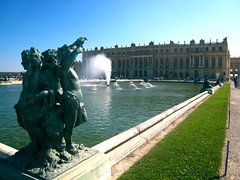 Louis XIV had the Palace of Versailles, originally a hunting lodge built by his father, converted into a spectacular royal palace in a series of four major and distinct building campaigns, says Wikipedia.
Louis XIV had the Palace of Versailles, originally a hunting lodge built by his father, converted into a spectacular royal palace in a series of four major and distinct building campaigns, says Wikipedia.
By the end of the third building campaign, the château had taken on most of the appearance that it retains to this day, except for the current chapel built in the last decade of the reign. He officially moved there, along with the royal court, on 6 May 1682.
Louis had several reasons for creating such a symbol of extravagant opulence and stately grandeur, and for shifting the seat of the monarchy. The assertion that he did so because he hated Paris, however, is flawed as he did not cease to embellish his capital with glorious monuments while improving and developing it. On the other hand, contemporary writers such as Saint-Simon speculated that Louis viewed Versailles as an isolated power center where treasonous cabals could be more readily recognized.[15]
Versailles served as a dazzling and awe-inspiring setting for state affairs and for the reception of foreign dignitaries, where the attention was not shared with the capital and the people, but was assumed solely by the person of the king. Thus, many noblemen had perforce either to give up the cachet and opportunites associated with sharing in the king's company, or to depend entirely on the king for the grants and subsidies necessary to do so in proper style.[15] Instead of exercising power and potentially creating trouble, the nobles vied for the honour of dining at the king's table or the privilege of carrying a candlestick as the king retired to his bedroom.
From 1682, when King Louis XIV moved from Paris, until the royal family was forced to return to the capital in 1789, the Court of Versailles was the centre of power in Ancien Régime France. Versailles is therefore famous not only as a building, but as a symbol of the system of absolute monarchy which Louis XIV espoused.
 1. Louis XIV was the king who sparked the French Revolution of 1789. T / F
1. Louis XIV was the king who sparked the French Revolution of 1789. T / F
2. The Palace of Versailles is in Paris near the bank of the River Seine. T / F
3. The famous queen of King Louis XIV was Marie Antoinette. T / F
4. There is little doubt that Louis XIV was homosexual. T / F
5. How vast was Versailles? For instance, how many rooms?
a) 300 b) 700 c) 999.
6. Louis forced the independent-minded noblemen of France to change something about their lives. a) their residence. b) number of servants allowed. c) all forced to serve in the military.
7. Consider the magnificent chateau created by Nicholas Fouquet, the Finance Minster under Louis XIV. Called Vaux le Vicomte, when it was completed it was finer than anything owned by the King. What was the fate of the Minister of France once his chateau had been seen by the King?
8. Why did Louis XIV change his residence from the Palais du Louvre to the Chateau de Versailles?
9. To win the favor of Louis XIV at Versailles, a nobleman would be expected to take what sort of lessons?
10. Based on a role that he danced in a grand fete, what was the famous nickname of Louis XIV? And en Francais?
1. While he spent too much of France's money on wars and luxury, the revolution did not begin until the reign of Louis XVI, some 60 years after the reign of Louis XIV.
2. Versailles is about 11 miles south of Paris. Today it is a city and a suburb of Paris.
3. Marie Antoinette was a victim of the Revolution and the guillotine in 1793; her husband was Louis XVI, and went to his execution in 1792.
4. Louis XIV was married twice and fathered many children. He also had several mistresses. So we assume that, despite his feminine appearance in royal portraits, he was heterosexual.
5. Wikipedia lists the number of rooms as 700.
6. Louis commanded all the nobles to move into Versailles. There he was able to pit them against each other and bring autocratic unity to France.
7. Fouquet was imprisoned for embezzling the King's money. The designers and craftsmen who created Vaux le Vicomte were taken to Versailles to create an even grander residence.
8. Louis changed his residence when he realized that the royal family was not safe from the rabble in Paris.
9. Louis loved dance, particularly ballet. To be his friend was to take dance lessons.
10. The Sun King: Le Roi Soleil.
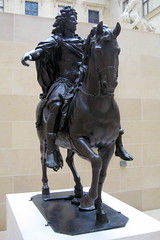 By moving his court and government to Versailles, Louis XIV hoped to extract more control of the government from the nobility, says Wikipedia. It also gave him distance from the population of Paris.
By moving his court and government to Versailles, Louis XIV hoped to extract more control of the government from the nobility, says Wikipedia. It also gave him distance from the population of Paris.
All the power of France emanated from this center: there were government offices here, as well as the homes of thousands of courtiers, their retinues, and all the attendant functionaries of court (Solnon, 1987). By requiring that nobles of a certain rank and position spend time each year at Versailles, Louis prevented them from developing their own regional power at the expense of his own and kept them from countering his efforts to centralise the French government in an absolute monarchy (Bluche, 1986, 1991; Bendix, 1978; Solnon, 1987).
The meticulous and strict court etiquette that Louis established, which overwhelmed his heirs with its petty boredom, was epitomised in the elaborate ceremonies and exacting procedures that accompanied his rising in the morning, known as the Lever, divided into a petit lever for the most important and a grand lever for the whole court. Like other French court manners, étiquette was quickly imitated in other European courts (Benichou, 1948; Bluche, 1991; Solnon, 1987).
The expansion of the château became synonymous with the absolutism of Louis XIV (Bluche, 1986, 1991). In 1661, following the death of Cardinal Mazarin, chief minister of the government, Louis had declared that he would be his own chief minister. The idea of establishing the court at Versailles was conceived to ensure that all of his advisors and provincial rulers would be kept close to him. He feared that they would rise up against him and start a revolt. He thought that if he kept all of his potential threats near him, that they would be powerless.
After the disgrace of Nicolas Fouquet in 1661 — Louis claimed the finance minister would not have been able to build his grand château at Vaux-le-Vicomte without having embezzled from the crown — Louis, after the confiscation of Fouquet’s state, employed the talents of Le Vau, Le Nôtre, and Le Brun, who all had worked on Vaux-le-Vicomte, for his building campaigns at Versailles and elsewhere.
 The Firebird (French: L'Oiseau de feu) is a 1910 ballet by Igor Stravinsky and choreographed by Michel Fokine. The ballet is based on Russian folk tales of the magical glowing bird of the same name that is both a blessing and a curse to its captor, says Wikipedia.
The Firebird (French: L'Oiseau de feu) is a 1910 ballet by Igor Stravinsky and choreographed by Michel Fokine. The ballet is based on Russian folk tales of the magical glowing bird of the same name that is both a blessing and a curse to its captor, says Wikipedia.
Stravinsky's ballet centers on the journey of its hero, Prince Ivan. Ivan enters the magical realm of Kashchei the Immortal; all of the magical objects and creatures of Kashchei are herein represented by a chromatic descending motif, usually in the strings.
While wandering in the gardens, he sees and chases the Firebird. The Firebird, once caught by Ivan, begs for its life and ultimately agrees to assist Ivan in exchange for eventual freedom.
Next, Prince Ivan sees thirteen princesses, with one of whom he falls in love. The next day, Ivan chooses to confront Kashchei to ask to marry one of the princesses; the two talk and eventually begin quarreling.
When Kashchei sends his magical creatures after Ivan, the Firebird, true to its pledge, intervenes, bewitching the creatures and making them dance an elaborate, energetic dance (the "Infernal Dance"). The creatures and Kashchei then fall asleep; however, Kashchei awakens and is then sent into another dance by the Firebird.
While Kashchei is bewitched by the Firebird she tells Ivan the secret to Kashchei's immortality and Ivan destroys it killing Kashchei. With Kashchei gone and his magic broken, the magical creatures and the palace all disappear, and all of the "real" beings (including the princesses) awaken and, with one final fleeting appearance from the Firebird, celebrate their victory.
 Johann Sebastian Bach (1685 – 1750) was a German composer and organist whose sacred and secular works for choir, orchestra, and solo instruments drew together the strands of the Baroque period and brought it to its ultimate maturity.[1]
Johann Sebastian Bach (1685 – 1750) was a German composer and organist whose sacred and secular works for choir, orchestra, and solo instruments drew together the strands of the Baroque period and brought it to its ultimate maturity.[1]
Although he introduced no new forms, he enriched the prevailing German style with a robust contrapuntal technique, an unrivalled control of harmonic and motivic organisation in composition for diverse instrumentation, and the adaptation of rhythms and textures from abroad, particularly Italy and France, says Wikipedia.
While Bach's fame as an organist was great during his lifetime, he was not particularly well-known as a composer. His adherence to Baroque forms and contrapuntal style was considered "old-fashioned" by his contemporaries, especially late in his career when the musical fashion tended towards Rococo and later Classical styles.
A revival of interest and performances of his music began early in the 19th century, and he is now widely considered to be one of the greatest composers in the Western tradition.
Mozart, Beethoven, and Chopin were among his most prominent admirers.
He fathered 20 children by 2 wives. Was a devout Lutheran. Worked longest in the city of Leipzig.
Toccata and Fugue in D minor has been enormously popular and has been used frequently by rock musicians. His work called Air on a G String (really) is very widely known and used in much media. His solo work for cello is a favorite of your teacher. The Brandenberg Concertos are widely regarded as among the finest musical compositions of the Baroque era.
During his life he composed more than 1,000 works.
Bach died in 1750 at the age of 65. A contemporary newspaper reported the cause of death was "from the unhappy consequences of the very unsuccessful eye operation".[14] Some modern historians speculate the cause of death was a stroke complicated by pneumonia.
 Chopped and screwed, says Wikipedia, refers to a technique of remixing hip hop music which developed in the Houston hip hop scene in the 1990s. Thus Fine Arts class learned from Jordan Mitchell, student rap artist and record producer.
Chopped and screwed, says Wikipedia, refers to a technique of remixing hip hop music which developed in the Houston hip hop scene in the 1990s. Thus Fine Arts class learned from Jordan Mitchell, student rap artist and record producer.
Mr. T had read about the phenomenon in the NY Times but had not heard any of the music. He immediately proclaimed the sludgy but shimmering sound, "the psychedelia of the new century."
Records are manipulated by slowing the tempo and applying techniques such as skipping beats, record scratching, stop-time, and effecting portions of the music to make a "chopped-up" version of the original.
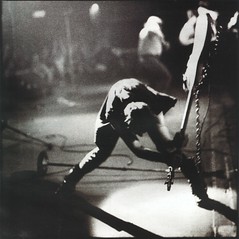 This is one of the defining images of frustrated youth in the 80's. It symbolised the lack of hope felt by English punks and gave a breath of life to the overall world of rock.
This is one of the defining images of frustrated youth in the 80's. It symbolised the lack of hope felt by English punks and gave a breath of life to the overall world of rock.
While other musicians had destroyed guitars (Jimi Hendrix burned his Strat) for the sake of entertainment (the Who blew up drums and also smashed guitars), the Clash brought authentic rage to the world of fast, simple rock.
 History of pop music in America / from rock to hip-hop
History of pop music in America / from rock to hip-hop
What is its impact on our lives?
How does it relate to the Fine Arts?
Has pop music been partly responsible for eroding the deleterious dictatorships and totalitarian regimes of the world?
The Dance Theater of Harlem recently performed classical European ballet moves to the James Brown funk song, "Mother Popcorn." The unexpected collision of the historical fine arts and the classical modern expression worked marvelously. People were amused and enlightened by the juxtaposition.
Specs:
- 10 slides on the assigned topic, 10 on your choice of additional topic.
- 3 recordings - mp3's - on each topic.
- Brief printed explanation to accompany each slide.
- store in Google Docs.
1. Gospel - what about gospel music provides a background for pop?
2. Folk - which fold musics have been inspirational to pop artists? Which folk songs have won a place in pop culture alongside rock and R n B?
3. Country music - what parts of country music contributed to the birth of r n r? How has country become sort of a variation of rock?
4. Blues - what qualities of the blues are bedrock parts of pop?
5. R n B - early forms of RnB were called Race music and were immediate predecessors to the rock revolution.
6. Leo Fender and the revolutionary aspects of developing the Fender guitars, amps and bass.
Part One: the Strat and the Tele.
7. Leo Fender 2: pop music and the impact of the P Bass and the Jazz Bass, too.
8. Leo Fender 3: guitar amplifiers that changed the world - the Deluxe, the Bassman, the Super.
9. Les Paul and the Gibson Les Paul guitar and pop music.
10. Les Paul and multi-track recording. Pop music and technology.
11. Hair and the excitement and image of pop stars.
12. Costumes of pop music: from the ducktail to the feather boa.
13. Dance and pop music: get them on the dance floor and you will be a success.
14. Drugs and pop culture. From Liquor to Horse to PCP.
15. Urban and African-American slang and pop music. The language of pop.
16. Movies that brought pop music and pop culture to the masses.
17. TV and the pop star: how TV fed the appetite and spread the culture of pop.
18. Radio and the development of pop.
19. 1950's rock: the initial revolutionary confluence of musics and heroic performers.
20. Black culture meets white culture and America is revolutionized.
21. British rock: in the 1960's talented people in one European nation shook the smug Yanks.
22. Singer-songwriters and pop music: in the 7o's multi-talented performers established a sort of folk-rock category.
23. Punk: the British and the urban background of million-sellers like Green Day.
24. Psychedelia: drug-drenched, stately pop music that reflected poetic space journeys.
25. Metal and Heavy rock: grinding guitars and basic riffs seem eternally part of pop.
26. Progressive rock: jazzy and complicated.
27. Icons: Ray Charles
28. Icons: Little Richard
29. Icon: Chuck Berry
30. Icon: Michael Jackson
31. Icon: the Beatles
32. Icon: Jimi Hendrix
33. Icon: Bob Dylan
34. Icon: Prince
35. Icon: Stevie Wonder
36. Modern icon: Radiohead
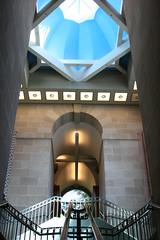 Washington, DC, is a mecca for art lovers. Here are the principal museums -
Washington, DC, is a mecca for art lovers. Here are the principal museums -
1. Sackler Museum of Asian Art
2. Museum of African Art
3. Freer Gallery of Asian Art
4. Hirshorn Museum of modern art and sculpture
5. National Portrait Gallery
6. National Gallery of Art (both West Bldg and East wing, the modern)
7. National Sculpture Garden
8. Corcoran Gallery and art school
9. The Phillips Collection
10. Dumbarton Oaks
There are numerous additional museums such as the Textile Museum and the Howard University Museum of Art.
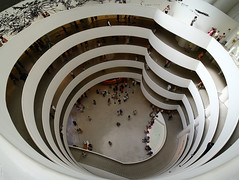 The Solomon R. Guggenheim Museum, which opened in 1959, is one of the best-known museums in New York City and one of the 20th century's most important architectural landmarks, says Wikipedia.
The Solomon R. Guggenheim Museum, which opened in 1959, is one of the best-known museums in New York City and one of the 20th century's most important architectural landmarks, says Wikipedia.
Designed by Frank Lloyd Wright, the museum––which is often called simply The Guggenheim––is home to a renowned permanent collection of Impressionist, Post-Impressionist, early Modern, and contemporary art, and also features special exhibitions throughout the year.
The distinctive building, Wright's last major work, instantly polarized architecture critics upon completion,[2] though today it is widely revered.[3] From the street, the building looks approximately like a white ribbon curled into a cylindrical stack, slightly wider at the top than the bottom. Its appearance is in sharp contrast to the more typically boxy Manhattan buildings that surround it, a fact relished by Wright who claimed that his museum would make the nearby Metropolitan Museum of Art "look like a Protestant barn."[2]
Internally, the viewing gallery forms a gentle helical spiral from the ground level up to the top of the building. Paintings are displayed along the walls of the spiral and also in exhibition space found at annex levels along the way.
Most of the criticism of the building has focused on the idea that it overshadows the artworks displayed within, and that it is particularly difficult to properly hang paintings in the shallow windowless exhibition niches that surround the central spiral.
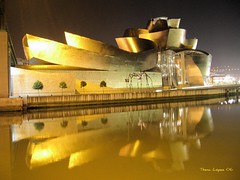 The Guggenheim Museum Bilbao is a modern and contemporary art museum designed by Canadian-American architect Frank Gehry, built by Ferrovial[1] and located in Bilbao, Basque Country, Spain. It is built alongside the Nervion River, which runs through the city of Bilbao to the Atlantic Coast, says Wikipedia.
The Guggenheim Museum Bilbao is a modern and contemporary art museum designed by Canadian-American architect Frank Gehry, built by Ferrovial[1] and located in Bilbao, Basque Country, Spain. It is built alongside the Nervion River, which runs through the city of Bilbao to the Atlantic Coast, says Wikipedia.
The curves on the building have been designed to appear random. The architect has been quoted as saying that "the randomness of the curves are designed to catch the light". Designed by Canadian/American architect Frank Gehry and opened to the public in 1997, it was immediately vaulted to prominence as one of the world's most spectacular buildings in the style of Deconstructivism, although Frank Gehry does not associate himself with this architectural movement. Architect Philip Johnson called it "the greatest building of our time".[2]
 Drum sets were first developed due to financial and space considerations in theaters where drummers were encouraged to cover as many percussion parts as possible, says Wikipedia. Up until then, drums and cymbals were played separately in military and orchestral music settings. Initially, drummers played the bass and snare drums by hand, then in the 1890s they started experimenting with footpedals to play the bass drum. William F. Ludwig made the bass drum pedal system workable in 1909, paving the way for the modern drum kit.
Drum sets were first developed due to financial and space considerations in theaters where drummers were encouraged to cover as many percussion parts as possible, says Wikipedia. Up until then, drums and cymbals were played separately in military and orchestral music settings. Initially, drummers played the bass and snare drums by hand, then in the 1890s they started experimenting with footpedals to play the bass drum. William F. Ludwig made the bass drum pedal system workable in 1909, paving the way for the modern drum kit.
By World War I drum kits were characterized by very large marching bass drums and many percussion items suspended on and around it, and they became a central part of jazz music. Hi-hat stands appeared around 1926.
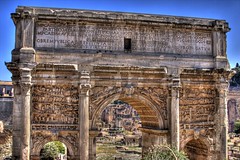 Pompeii / Herculaneum 79 AD
Pompeii / Herculaneum 79 AD
- ash & volcanic mud inundate the coastal resort cities.
- highest standard of living in western world
* Roman city design has distinct impact on western world to this day.
* Pax Romana: "Peace of the Romans," 150-year period of stability and relative peace in Mediterranean world.
* Romulus & Remus and the mother wolf legend in founding of Roma.
* Collapse of empire about 400 AD.
* City of Roma at peak: 1 million inhabitants; noisy, congested, expensive.
* Forum at heart of city: politics, temples, marketplace.
- Julius Caesar defeats Gauls (Celts) after generations of struggle in Gaul.
- Augustus Caesar builds cities in Gaul (France) to solidify the conquest.
- "The Romans have spanned the sacred river." Druids, the Celtic priest class, oppose the Latins.
* Aqueducts: movement of water via gravity. Water to reservoir. Thence to public fountains, bathhouses, homes of the wealthy.
* Thermae: bathhouses based on 3 pools:
- tepidarium (tepid)
- caldarium (hot)
- frigidarium (frigid)
- additionally: exercise, news, eating, laundry.
* Concrete developed by Romans.
- Stone and cement.
- Was a plastic building material.
* Roman villa
- atrium: central hall, open to sky.
- impluvium: pool in floor of atrium; water to house's reservoir.
- house oriented inward.
- peristyle: shaded area surrounds garden.
- slave labor.
* Ostia - city on Mediterranean close to Rome.
* Insulae: apartment buildings ("islands")
* Circus Maximus: chariot races in enormous stadium.
* epicurian skills: care for food.
* portents: symbols of future happenings seen in natural events.
* Greeks: source of ideas, sense of style, art, for Romans.
*Depraved entertainment in coliseum:
- crowds cheered deaths of prisoners, defeated enemies, minority groups.
- sense of order maintained.
- militaristic spirit satisfied.
- death at a symbolic level for the audience.
 To study the classics is to invest in your future. All your life you will see references to Egypt, Greece and Rome in movies, literature, journalism, sitcoms and in conversation with educated people.
To study the classics is to invest in your future. All your life you will see references to Egypt, Greece and Rome in movies, literature, journalism, sitcoms and in conversation with educated people.
Check out this perspective on Classics at worldbookonline.com.
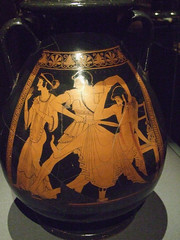 The map of this mega-influential Mediterranean region -
The map of this mega-influential Mediterranean region -
- Medi terra anean
- Aegean Sea
- Black Sea
- Red Sea
- Italy
- Greece
- Macedonia
- Asia Minor (Turkey)
- Syria
- Phoenicia (Lebanon)
- Palestine / Judaea (Israel)
- Sinai Peninsula
- Egypt
- Libya
- Alexandria
- Jerusalem
- Troy
- Byzantium (Constantinople, Istanbul)
- Athens
 Myron of Eleutherae - 480-440 BC - was an Athenian sculptor, says wikipedia.org. He was born in Eleutherae on the borders of Boeotia and Attica.
Myron of Eleutherae - 480-440 BC - was an Athenian sculptor, says wikipedia.org. He was born in Eleutherae on the borders of Boeotia and Attica.
Chionis, a seventh century Olympic victor from Sparta, was commemorated in this idealized bronze by Myron.
He worked almost exclusively in bronze:[4] and though he made some statues of gods and heroes, his fame rested principally upon his representations of athletes, in which he made a revolution, according to commentators in Antiquity, by introducing greater boldness of pose and a more perfect rhythm, subordinating the parts to the whole.
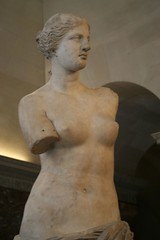 The Aphrodite of Milos, better known as the Venus de Milo, is one of the most famous works of ancient Greek sculpture.
The Aphrodite of Milos, better known as the Venus de Milo, is one of the most famous works of ancient Greek sculpture.
Created at some time between 130 and 100 BC, it is believed to depict Aphrodite (called Venus by the Romans), the Greek goddess of love and beauty.
It is a marble sculpture, slightly larger than life size at 6.7 ft high, says Wikipedia. Its arms and original plinth have been lost. From an inscription that was on its plinth, it is thought to be the work of Alexandros of Antioch; it was earlier mistakenly attributed to the master sculptor Praxiteles.
It is at present on display at the Louvre Museum in Paris.
Although the Venus de Milo is widely renowned for the mystery of her missing arms among people unfamiliar with any other incomplete Greek or Roman sculpture,[1] enough evidence remains to prove that the right arm of the goddess was lowered across the torso with the right hand resting on the raised left knee so the sliding drapery wrapped around the hips and legs could be held in place.
I've seen a bit of sagging, but this example of lowriding is off the hook.
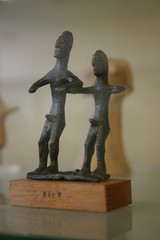 tudents must have an acquaintanceship with the Greek view of sexuality and the arts.
tudents must have an acquaintanceship with the Greek view of sexuality and the arts.
From a video in our school library, part of a series called Greek Fire:
"Ancient Greek myths invlove endless tales of seduction. In ancient Greek pottery, painting and poetry, you will find exuberant sexuality and uninhibited acitivity in abundance.
Sappho of the island of Lesbos - the first poetess of the Western world - gives her name to lesbianism. Male homosexuals can turn back to Plato to find that their way of life was regarded as noble and praiseworthy.
But ancient Greece was no sexual utopia. In Greek drama, there is a profound male terror in front of the mystery of woman. Men saw in women something dark, shadowy and pre-rational."
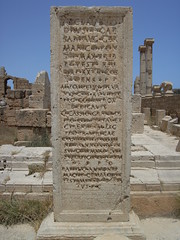 Phoenicia was an ancient civilization centered in the north of ancient Canaan, with its heartland along the coastal regions of modern day Lebanon, Syria and Israel, says Wikipedia.
Phoenicia was an ancient civilization centered in the north of ancient Canaan, with its heartland along the coastal regions of modern day Lebanon, Syria and Israel, says Wikipedia.
Phoenician civilization was an enterprising maritime trading culture that spread across the Mediterranean between the period of 1550 BC to 300 BC. Though ancient boundaries of such city-centered cultures fluctuated, the city of Tyre seems to have been the southernmost. Sarepta (modern day Sarafand) between Sidon and Tyre, is the most thoroughly excavated city of the Phoenician homeland. The Phoenicians often traded by means of a galley, a man-powered sailing vessel and are credited with the invention of the bireme.[2]
It is uncertain to what extent the Phoenicians viewed themselves as a single ethnicity. Their civilization was organized in city-states, similar to ancient Greece. Each city-state was an independent unit politically, although they could come into conflict, be dominated by another city-state, or collaborate in leagues or alliances. Tyre and Sidon were the most powerful of the Phoenician states in the Levant, but were not as powerful as the North African ones.[citation needed]
The Phoenicians were also the first state-level society to make extensive use of the alphabet, and the Canaanite-Phoenician alphabet is generally believed to be the ancestor of all modern alphabets.
Phoenicians spoke the Phoenician language, which belongs to the group of Canaanite languages in the Semitic language family. Through their maritime trade, the Phoenicians spread the use of the alphabet to North Africa and Europe where it was adopted by the Greeks, who later passed it on to the Romans and Etruscans.[3] In addition to their many inscriptions, the Phoenicians wrote many books, which have not survived.
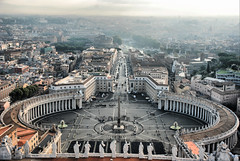 The Romans took over the Mediterranean when the Greeks faltered militarily. The Greek arts were recognized by the Romans as something worthy of having, so the Latins copied the Greeks' work and took Greeks home to do the teaching.
The Romans took over the Mediterranean when the Greeks faltered militarily. The Greek arts were recognized by the Romans as something worthy of having, so the Latins copied the Greeks' work and took Greeks home to do the teaching.
Let us dive in upon the Roman arts. For the sake of this unit we will expand the artful architectural world to include building technology. For the Romans taught the world much about the art of engineering.
Each powerpoint report should face the issue of what was different between the Roman and earlier Greek version of the item.
Please follow the roll and use the same number you were given in the recent Greek unit.
1. music
2. musical instruments
3. costume
4. dance
5. pottery
6. ship design
7. artful implements of war
8. architecture
9. Roman arch
10. aqueducts
11. Roman Republic
12. Augustus Caesar
13. Julius Caesar
14.. Coliseum of Rome
15. Etruscans
16. theaters
17. public baths
18. Roman forum
19. Roman arch and dome
20. Pantheon
21. Roman feast & cuisine
22. Virgil and the Aeneid
23. mosaics
24. trompe l’oeil painting
25. Church of Hagia Sophia in Constantinople
26. Pompeii and its art
27. Roman fountains
28. Roman ghetto
29. Triumphal arch
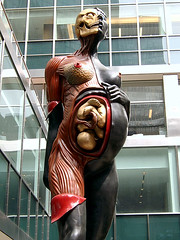 Damien Hirst (born 7 June 1965) is an English artist and the most prominent of the group that has been dubbed "Young British Artists" (or YBAs), says Wikipedia.
Damien Hirst (born 7 June 1965) is an English artist and the most prominent of the group that has been dubbed "Young British Artists" (or YBAs), says Wikipedia.
Hirst dominated the art scene in Britain during the 1990s and is internationally renowned. During the 1990s his career was closely linked with the collector Charles Saatchi, but increasing frictions came to a head in 2003 and the relationship ended.
Death is a central theme in Hirst's works. He became famous for a series in which dead animals (including a shark, a sheep and a cow) are preserved—sometimes having been dissected—in formaldehyde. His most iconic work is The Physical Impossibility of Death in the Mind of Someone Living, a 14-foot (4.3 m) tiger shark immersed in formaldehyde in a vitrine. Its sale in 2004 made him the world's second most expensive living artist after Jasper Johns.
In June 2007, Hirst overtook Jasper Johns when his Lullaby Spring sold for £9.65 million at Sotheby's in London.[1] On 30 August 2007, Hirst outdid his previous sale of Lullaby Spring with For The Love of God which sold for £50 million to an unknown investment group. [2] He is also known for "spin paintings," made on a spinning circular surface, and "spot paintings," which are rows of randomly-coloured circles.
In September 2008, he took an unprecedented move for an artist of his status by selling a complete show, Beautiful Inside My Head Forever, at Sotheby's by auction and by-passing his long-standing galleries,[3] The auction exceeded all predictions, raising £111 million ($198 million), breaking the record for a one-artist auction[4] as well as Hirst's own record with £10.3 million for The Golden Calf, an animal with 18-carat gold horns and hooves, preserved in formaldehyde.[3]
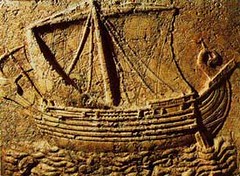 1. Phoenicia was an ancient civilization centered in the north of Canaan, with its heartland along the coastal regions of modern day Lebanon, Syria and __ .
1. Phoenicia was an ancient civilization centered in the north of Canaan, with its heartland along the coastal regions of modern day Lebanon, Syria and __ .
2. The Levant was an ancient region in the Eastern end of the Mediterranean. T / F
3. In the realm of language and literature, the Phoenicians are credited with development of the __ .
4. Phoenicians must be related to the Jewish peoples. T / F
5. Jabal is Arabic for a) monument b) mountain c) knife wound d) mascara.
6. Spain makes the biggest part of what we refer to as the __ Peninsula.
7. The Muslim Arabs invaded Christian European territory
by ship. T / F
8. S’il vous plait must mean a) thank you b) best regards
c) please d) if you must go . . .
9. Drama, including tragedy and comedy, is one of the arts that was not created by the Romans nor by the Greeks.
T / F
10. The Times review of Abby Singer’s Bistro featured two pieces of grilled, marinated __, which were served on a bed of arugula with tomatoes, olives and prosciutto.
11. The Times reviews notes that “My friend scrapped off the onions — not an onion person myself, I couldn't blame her.” That was a) illiterate in at least 2 ways b) a marvelous moment to share with the reader.
12. The two principal elements of a review, according to your teacher, are __ and __ .
13. Sparta vs Athens: the wars that took place about 400 BCE on the __ Peninsula.
14. To the Greeks, withholding intimate contact from their husbands - to stop the war - seems to be a a) ridiculous idea b) clever idea in a play by Aristophanes called Lysistrata.
15. Characterized by sinuous, asymmetrical lines based on plant forms, this style was used in architecture, interior design, graphic art and design, jewelry, and glass. It was international in scope and was called __ __ .
Answers -
1. Israel
2. true
3. alphabet
4. true
5. b mountain
6. Iberian
7. true
8. c please
9. false
10. mozzarella / cheese
11. a illiterate
12. description, evaluation
13. Peloponnese
14. a ridiculous
15. art nouveau
 While most of my students know a bit about Egypt, there is always more to learn.
While most of my students know a bit about Egypt, there is always more to learn.
In 1992 I studied in Egypt on a Fulbright Group Seminar grant. After six weeks in Egypt I had visited the nation from coast to coast but I had only begun a decades-long study.
The ancient Egyptians were obsessed with art of every kind - not in the way of the modern world, but in a very productive, ancient way. We will study much more than their architecture. The class will also explore their
- jewelry
- dance
- music
- sculpture
- painting
- drama
 Additionally, students must demonstrate knowledge of a brief map of Egypt comprising, artfully, the following:
Additionally, students must demonstrate knowledge of a brief map of Egypt comprising, artfully, the following:
1. Alexandria & Cairo
2. Lower and Upper Nile
3. Sinai peninsula
4. Giza
5 Heliopolis
6. Valley of the Kings
7. Karnak / Luxor
8. Abu Simbel
9. Mediterranean and Red Seas
 Rembrandt Harmenszoon van Rijn (1606 – 1669) was a Dutch painter and etcher. He is generally considered one of the greatest painters and printmakers in European art history and the most important in Dutch history, says Wikipedia.[1] His contributions to art came in a period that historians call the Dutch Golden Age.
Rembrandt Harmenszoon van Rijn (1606 – 1669) was a Dutch painter and etcher. He is generally considered one of the greatest painters and printmakers in European art history and the most important in Dutch history, says Wikipedia.[1] His contributions to art came in a period that historians call the Dutch Golden Age.















































